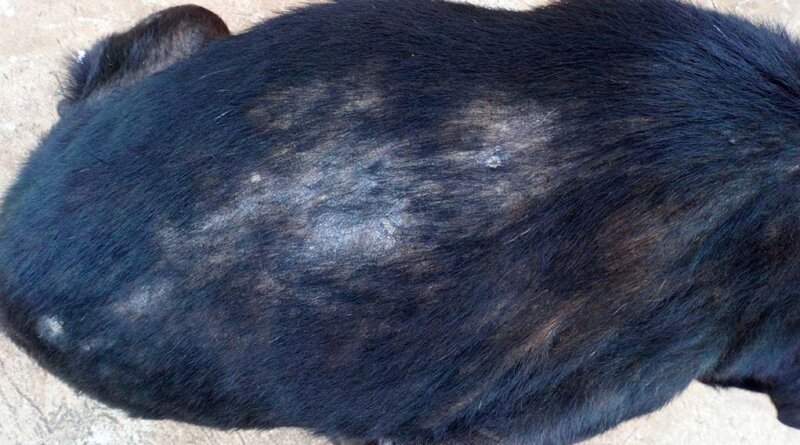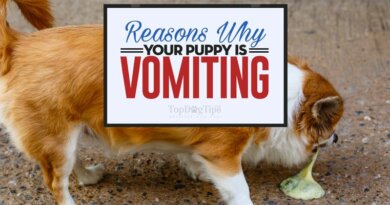5 Reasons Why It Happens and What To Do
It is not uncommon for a dog to suffer from alopecia, dog hair loss. Or hair thinning and loss. This condition is separate from the natural act of shedding fur.
Shedding is when dogs naturally lose their old or damaged hair, with the amount and frequency depending on health and breed. Alopecia in dogs, or hair loss, is a common disorder that causes partial or complete dog hair loss.
It can affect your pet’s skin and its endocrine system, lymphatic system, and immune system. Alopecia can affect dogs of all ages, breeds, and gender.
For the most part, dog hair loss will be very noticeable to owners, showing up in different patterns and shapes.
It can be sporadic or symmetrical hair loss or maybe shown as bald circles. Both can be accompanied by crusting and inflammation of the dog’s skin.
In sporadic cases, the dog may have scaling of the skin too.
ALSO READ: 9 Ways to Improve Your Dog’s Skin and Coat Health
What Causes Dog Hair Loss?
Hair loss in dogs may be caused by many reasons, including allergies, infections, and parasites.
Depending on the underlying cause, canine alopecia may be accompanied by infection and irritation, along with possible reddening of the skin and the affected area.
There are five most common causes of dog hair loss that pet owners will encounter, along with treatments and preventative measures that can assist in the care of your pooch.
1. Allergies
Allergies are a common underlying cause of many symptoms experienced by dogs. They can act as a trigger for pet hair loss whenever the dog has an allergic reaction to their environment, foods, or parasites.
Dogs often suffer from a flea allergy, leading to increased licking and biting of the irritated areas.
The flea bite can create an allergic reaction that can last for days, providing the dog with an extended need to itch, scratch, lick, and irritate the already irritated skin, ultimately causing hair loss.
Discovering the exact allergen can help prevent allergic reactions in dogs. If it is a food allergy, switch brands or food types, or try homemade recipes.
For fleas, take preventative measures such as monthly flea medication; if there is an infestation on the dog, wash your pooch using a flea shampoo and give him a flea-removing oral medication that kills fleas in 2-8 hours.
It may be an environmental allergen, talk to the vet about starting allergy medication or shots to reduce their irritation.
2. Cushing’s Disease Causes Dog Hair Loss
Hyperadrenocorticism, or Cushing’s Disease, is a condition caused by an overproduction of a cortisol hormone, which helps dogs respond to stress and modulates the immune system.
Dog hair loss is not the only symptom of Cushing’s Disease – it is usually accompanied by a lack of energy, bruising, obesity, and increased hunger, thirst, urination, and panting.
It mainly affects middle-aged to older dogs rather than puppies or adolescent dogs.
After the vet has officially determined that your pooch has Cushing’s Disease, the treatment will vary by how severe the condition is. If it’s caused by medication, they will slowly wean the dog off the medicine.
When the dog is only experiencing mild symptoms, you will monitor it instead of treated it immediately. If the dog’s symptoms become worse, a vet will prescribe trilostane.
This medication comes with dangerous side effects, which is why your veterinarian will wait until it is necessary to specify it rather than using it as a preventative measure.
3. Major Dog Hair Loss Occurs With Mange
Mange is an inflammatory disease caused by the Demodex mite. As the number of mites living in the hair follicles and skin of the dog increases, it can lead to lesions, infections, and dog hair loss.
Mange can either be localized, only affecting specific areas of the dog’s skin, or it can be generalized and affect the entirety of your pup’s body.
Usually, the mites inhabiting the surface of the dog do not change their hair or skin, but when the numbers grow out of control, it becomes damaging to their fur.
Mange does not require treatment when it is to a small degree. It will usually disappear on its own, doing so spontaneously.
Whenever it reaches a severe stage, often when generalized and not sporadic, the vet will recommend long-term medications to control the condition. If the dog is a female, it should be spayed.
Fluctuations in hormones can exacerbate the symptoms. Changing to high-quality dog food and a low-stress environment may be able to reduce flare-ups.
4. Ringworm
Ringworm is a fungal infection that lives and grows in the skin and hair follicles of infected dogs, occasionally infecting the nails. The infection is normally only a surface infection and only affects a few areas of the dog’s body.
Any dog can get ringworm. It affects puppies, senior dogs, and immunocompromised dogs more intensely. It can lead to widespread ringworm infections on their bodies.
Ringworm is infectious and spreads through direct contact, contaminated objects, and people. Dog hair loss is one of the common symptoms of this condition.
Again, the treatment of this infection depends on its severity, making it a dog-by-dog case. The vet will usually determine the severity after a physical exam and a diagnostic test using a sample of your pet’s hair and/or skin cells.
Typically, the treatment process goes through three steps. First, a vet will suggest topical therapy consisting of either a cream, ointment, or medicated shampoo. Second, they will prescribe an anti-fungal oral medication to fight the infection.
The third step consists of environmental decontamination. The removal and cleaning of all loose hairs found on couches, grooming tools, furniture, clothing, and bedding removes the infectious spores.
5. Rashes and Hives Can Cause Dog Hair Loss
Insect bites and stings, plants, chemicals, shampoos, and medications can cause rashes. They can also cause hives on the dog’s body and then lead to alopecia in dogs.
These can also include allergic rashes, which are separate from allergies. Allergic rashes and hives typically appear within hours. Sometimes minutes of exposure, while other symptoms may arise, such as listlessness, fever, and vomiting.
The allergic rash or hive-site in dogs often goes bald, causing the hair to fall out.
Allergic rashes and hives require further treatment than simply removal of the allergens. This is often a reaction requiring immediate treatment from the vet to prevent a more substantial, full-body condition.
READ NEXT: The Best Dog Food for Sensitive Skin
Pin and share with other dog owners:











Wow that was strange. I just wrote an extremely long comment but after I clicked submit my comment didn’t appear.
Grrrr… well I’m not writing all that over again. Anyhow, just wanted to say fantastic blog!
Wow that was strange. I just wrote an incredibly long comment but after I clicked submit my comment didn’t appear.
Grrrr… well I’m not writing all that over again.
Anyhow, just wanted to say wonderful blog!
Do you have a spam problem on this site; I also am a blogger,
and I was wanting to know your situation; many of us have developed some nice procedures and we
are looking to exchange methods with others, why not shoot me an email
if interested.
Hey there! This post couldn’t be written any better!
Reading through this post reminds me of my old room mate!
He always kept chatting about this. I will forward this post to him.
Fairly certain he will have a good read. Many thanks for sharing!
There’s definately a lot to learn about this issue. I really like all
the points you have made.
What’s up friends, its fantastic piece of writing regarding educationand completely defined,
keep it up all the time.
Keep on working, great job!
Hello there! I could have sworn I’ve been to this site before but after browsing
through some of the post I realized it’s new to me. Anyways, I’m
definitely glad I found it and I’ll be book-marking and checking
back often!
Have you ever thought about adding a little bit more than just
your articles? I mean, what you say is valuable and everything.
Nevertheless think of if you added some great images or videos to give your posts
more, “pop”! Your content is excellent but with images and video clips, this website could undeniably be one
of the greatest in its niche. Superb blog!
Just want to say your article is as astonishing.
The clearness in your post is simply nice and
i could assume you’re an expert on this subject.
Fine with your permission allow me to grab your feed to keep updated with forthcoming
post. Thanks a million and please keep up the gratifying work.
Hi there, its pleasant article about media print, we all
understand media is a fantastic source of facts.
I blog often and I truly appreciate your content.
The article has truly peaked my interest. I’m going to book mark your site and keep checking for new details about once per week.
I opted in for your RSS feed as well.
darknet sites deep web drug links darknet drug store